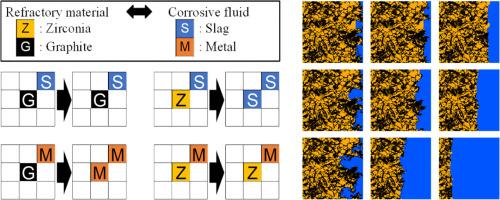ZrO2-C耐火材料熔渣/金属界面局部腐蚀的元胞自动机建模
IF 2.8
Q1 MATERIALS SCIENCE, CERAMICS
引用次数: 0
摘要
了解ZrO₂-C (ZG)耐火材料的局部腐蚀机制对于延长浸入式喷嘴(SEN)的使用寿命和提高连铸效率至关重要。本研究分析了ZG耐火材料在钢水与模具助熔剂接触的熔渣/金属界面处的局部腐蚀。耐火材料的润湿性显著影响ZrO₂含量和腐蚀速率。为了阐明这些相互作用,我们开发了一个专注于渣/金属界面的模型,并结合了二维元胞自动机(CA)方法。利用实际的ZG微结构,CA模拟可视化了腐蚀行为,揭示了新的见解。尽管只考虑润湿性变化,但该模型成功地复制了(1)观察到的ZrO₂含量与腐蚀速率之间的相关性,以及(2)腐蚀深度和ZrO₂面积分数随时间的变化。这些结果是在含有79和86 wt.% ZrO₂的ZG耐火材料中,zc =0.01, 0.15和0.50的临界ZrO₂面积分数得到的。研究结果支持耐火材料设计和工艺参数的优化。本文章由计算机程序翻译,如有差异,请以英文原文为准。

Cellular automaton modeling of the local corrosion of ZrO2-C refractories at slag/metal interfaces
Understanding local corrosion mechanisms of ZrO₂-C (ZG) refractories is essential for extending submerged entry nozzle (SEN) lifespan and improving continuous casting efficiency. This study and analytically investigated local corrosion of ZG refractories at the slag/metal interface, where molten steel contacts mold fluxes. Refractory wettability significantly affects ZrO₂ content and corrosion rate. To elucidate these interactions, we developed a model focused on the slag/metal interface, incorporating a two-dimensional cellular automaton (CA) method. Using actual ZG microstructures, the CA simulation visualized corrosion behavior, revealing new insights. Despite considering only wettability changes, the model successfully replicated (1) observed correlations between ZrO₂ content and corrosion rate, and (2) time-dependent changes in corrosion depth and ZrO₂ area fraction. These results were achieved for critical ZrO₂ area fractions , , and in ZG refractories containing 79 and 86 wt.% ZrO₂. Findings support optimization of refractory design and process parameters.
求助全文
通过发布文献求助,成功后即可免费获取论文全文。
去求助
来源期刊

Open Ceramics
Materials Science-Materials Chemistry
CiteScore
4.20
自引率
0.00%
发文量
102
审稿时长
67 days
 求助内容:
求助内容: 应助结果提醒方式:
应助结果提醒方式:


